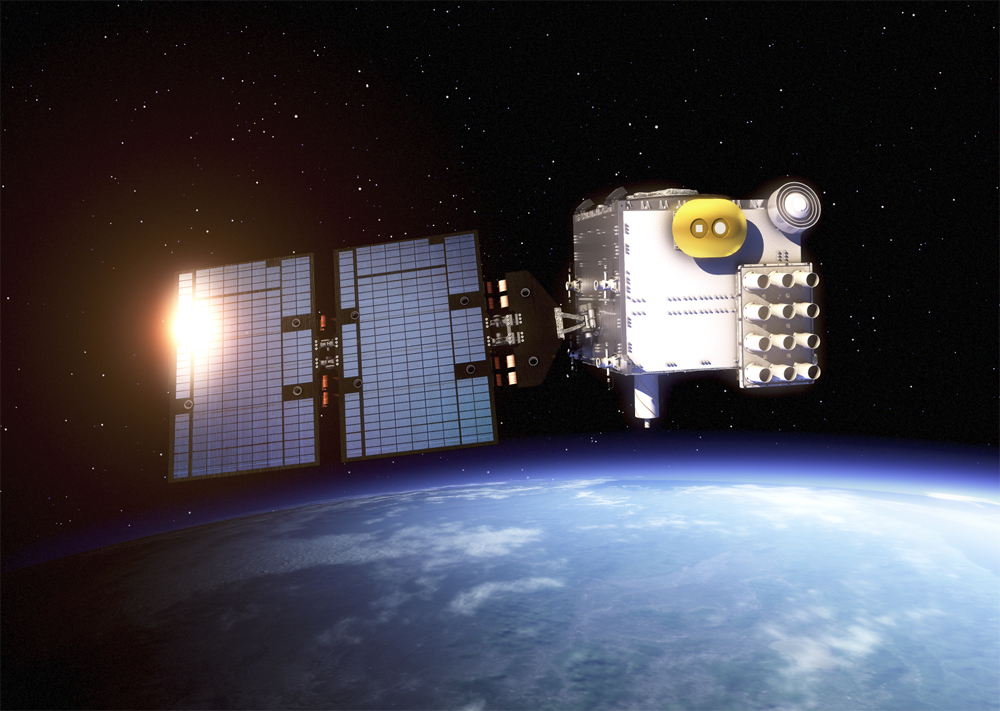Newly released satellite data poised to significantly improve weather forecasts
UCAR begins releasing first data from COSMIC-2 mission
Jan 13, 2020 - by David Hosansky
Jan 13, 2020 - by David Hosansky

An artist's rendering of a COSMIC-2 satellite. (Image: Surrey Satellite Technology Ltd.)
As the University Corporation for Atmospheric Research (UCAR) releases the first data from the newly launched COSMIC-2 satellite system, meteorologists are finding evidence that the detailed observations of the atmosphere will significantly improve short-term weather forecasts.
"The data are looking very good," said Bill Schreiner, director of the UCAR COSMIC program. "The mission is absolutely a success so far."
The six small satellites that form the second generation of the Constellation Observing System for Meteorology, Ionosphere, and Climate (better known as COSMIC-2) blasted into orbit last June. The satellites are equipped with an array of innovative sensors to probe large areas of the atmosphere with the goal of improving forecasts of hurricanes and other major storms. The system also provides critical information about upper atmospheric disturbances that can affect global communication and navigation systems and electrical power grids.
The data release is in partnership with the National Oceanic and Atmospheric Administration (NOAA).
In the past few months, scientists and engineers have begun to maneuver the satellites into their operational orbits and validate instrument performance. The system is already meeting the mission minimum requirement of 4,000 daily soundings, or profiles of the atmosphere that include information on temperature, humidity, and pressure as a function of altitude. Once operational, it is expected to produce close to 5,000 daily soundings. The quality of the observations is exceeding expectations, with an average signal-to-noise ratio that is approximately twice that of the original COSMIC satellites, which were launched in 2006.
UCAR last month started to release COSMIC-2 observations of the lower atmosphere every two weeks, after performing checks on the data for any quality control issues. Meteorological centers that have analyzed the data are reporting that the observations will provide a major boost to short-term weather forecasts.
"They've gone back to do impact studies, and they've found significant improvement in short-range forecasts when they assimilate the COSMIC-2 data into their models," Schreiner said. "This is evidence that COSMIC-2 will improve their forecast systems."
When instrument validation has been completed near the end of February, the quality-controlled data will be made available to the operational and research communities in near real-time. At that point, meteorologists will be able to use the observations in actual forecasts.
COSMIC-2 is a partnership among NOAA, the Taiwan National Space Organization, the U.S. Air Force, U.S. National Science Foundation, and UCAR. The system is known as Formosa Satellite #7 (FORMOSAT-7) in Taiwan.
COSMIC-2 is designed to probe Earth's atmosphere with a technique known as GNSS radio occultation. This measures the degree to which the radio signals sent by Global Navigation Satellite Systems (GNSS, which includes GPS) bend and slow as they pass through the atmosphere. The greater the bend and delay, the denser the atmosphere.
Those measurements can be further processed into information about temperature, pressure, and humidity, providing considerable data about a large volume of the atmosphere, from near-Earth orbit down to the surface.
The improved data are expected to provide an unprecedented view of weather systems in the tropics, including tropical cyclones. The observations will also provide new insights into climate phenomena such as monsoon patterns, the El Niño–Southern Oscillation, the Madden–Julian Oscillation, and the tropical convergence zones.
Schreiner said that one of the key advances will be the ability of the satellites to detect strong temperature inversions and sharp moisture gradients at the top of the atmospheric boundary layer, hundreds of feet to several miles above Earth's surface. Such observations can significantly improve computer models of weather processes.
Measurements made by GNSS radio occultation are highly accurate and therefore can be used to calibrate other ground-based and satellite observations. This accuracy is valuable to hurricane forecasters, who are interested in measurements of water vapor, the fuel that drives hurricanes and other tropical cyclones, at different heights in the atmosphere.
"COSMIC-2 will help us understand the details of water vapor and the hydrological cycle in the tropics, which is where most of our weather starts," Schreiner said. "We're going to see things we're never seen before."